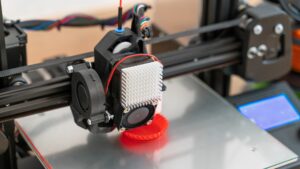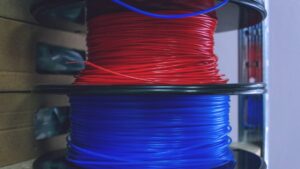
A Look at the Different Densities of 3D Printing Materials
There’s so much to learn about 3D printing materials. Come and find out what to look for when examining the different densities of 3D printing filaments.
844-810-1385
What do you need to work with nylon 3D printing filaments? Besides a 3D printer, you need special tools like a palette knife, a filament dryer or dry box, a deburring tool, and your filament of choice. As a beginner, you may struggle using nylon 3D printing filaments, and we want to improve the experience by providing four tips for you to use while 3D printing.
Your 3D printer creates objects from digital blueprints. The entire process works in layers, and the fiber you use for those layers can determine the quality of your product.
The instructor’s manual offers a more in-depth explanation of how all the controls work, how to insert your filament, and what you need to know about temperatures. However, it doesn’t mean you can use any filament. Some filaments require different 3D printer models.
The best printing technologies to use on nylon filaments include:
Print speed and settings can impact your entire creation process. Although not all 3D printer models support nylon, some models do. Usually, they will have a button to press if it supports the fiber. You need to know two sets of temperatures before printing anything: hot end and print bed temperatures.
When using the hot end, ensure the temperatures are between 240 and 260 degrees Celsius. Don’t go too low or high; you risk burning or not completely melting the fiber. For your first time, start at 245 degrees Celsius. This helps maintain the speed because the temperature increases the faster you print. Ensure you use a metal hot end before printing nylon, as it won’t stick because it doesn’t contain plastic parts.
For the print bed, a surface such as glass or garolite is ideal for getting your first layer to stick. Heating the print bed to around 70 degrees Celsius is a good starting point. Keep the cooling fan low or off to maintain warmth.
These settings differ from filament to filament, so when working with nylon glass fiber, you’re going to use very fine sandpaper to smooth out the layer lines. Even after creating with nylon, it still attracts moisture, so apply epoxy after printing to protect the surface.
Nylon is an excellent filament for 3D printing. It’s super light, flexible, and works well with other materials, like fabric and spray paint. However, the drawback is that it absorbs moisture fast, so you can’t leave spools sitting out for too long.
Here are the properties of nylon:
As a beginner, nylon is a difficult material to work with, but by following the tips on working with 3D printing filament for the first time, your experience improves. Shop with Filamatrix to find all you need for your 3D printing needs. We carry 50 years of filament knowledge so that you can achieve your printing endeavors.

There’s so much to learn about 3D printing materials. Come and find out what to look for when examining the different densities of 3D printing filaments.

Those interested in 3D printing have a lot to learn on how to use the system properly. Find out what you need to know about 3D printing and humidity levels.

3D printing has many variables that both beginners and experts need to know. Find out what effects temperature has on 3D printer filament.
Get professional insights, industry news, and our latest deals